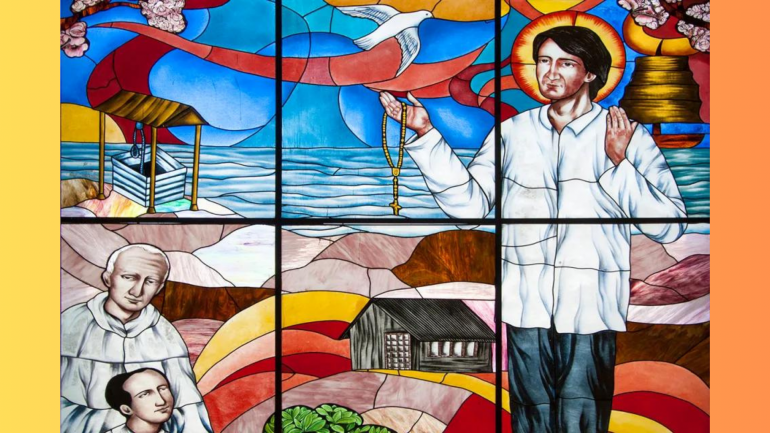Lorenzo Ruiz: the first Filipino protomartyr

Lorenzo Ruiz died two days later... in Nagasaki in 1637 at the age of 42, making him the first Filipino martyr for the Christian faith.
Lorenzo Ruiz was hung upside-down over a pit. He was physically abused to coerce him into giving up his faith. If he would renounce Christianity, the Japanese would spare him and set him free.
How did Ruiz get to Japan?
In 1636, he was falsely blamed for the death of a Spaniard in Manila. During that time he was a staff at a church in Binondo [now a district in Manila more popularly known as Chinatown].
To seek refuge overseas, he joined a mission in the same year. The mission was composed of three Dominican priests and a lay. One of the priests was Japanese.
He had no idea before he boarded the ship that it was bound for Japan. Only after the ship left Manila did he learn that they were heading to Japan.
But he and his companions were arrested and put in jail after setting foot in Japan.
At the time the Christians were being persecuted by the Tokugawa shogunate, the military government during the Edo period [1603-1868].
The first ever mission in Japan arrived in 1549 with St. Francis Xavier, a Spanish missionary who co-founded the Jesuits, as the head.
But the shogunate saw Christianity as a threat to their rule in Japan. And most of the persecutions of Christians happened during their rule, particularly in the 17th century.
Initially, the shogunate under Tokugawa Ieyasu demonstrated tolerance to Christian foreigners, especially as trade partners, resulting in the growth of Christianity in Japan.
But the attack on a Portuguese ship by Arima Harunobu, a Christian samurai lord, in 1610, and the Okamoto Daihachi incident in 1612 changed the shogunate's stance toward Christians.
The Okamato Daihachi incident was about an alleged conspiracy by Arima Harunobu to retake lands in Hizen lost to the Senguko wars.
Arima Harunobu was also a daimyo, a landholding magnate in feudal Japan, of the Shimabara Domain.
Hizen was an old Japanese province in Saga and Nagasaki prefectures. The Senguko period was marked by civil wars and social unrest during the 15th and 16th centuries.
As a result, the second shogun Tokugawa Hidetada issued an edict in 1612, banning the practice of Christianity in parts of Japan. Two years later in 1614, the shogunate banned Christianity in all of Japan.
Lorenzo and the other missionaries were arrested and put in prison. Then they were moved to Nagasaki, where they were subjected to brutal tortures.
Then they were transferred to Nishizaka Hill, where they were hung upside-down.
The torture was known as tsurushi, a method of punishment exploited by the shogunate to force Christians to turn their back from their faith. The body was bound tightly to slow down blood circulation. One of the prisoner's hands was bound tightly with a rope. The other hand was left free so that the prisoner could gesture that he would give up his faith.
Despite the brutality and suffering he sustained, Lorenzo did not renounce his faith. He chose Christianity over his life and freedom.
And what could be more painful than dying in a foreign land from a brutal death?
He died two days later from blood loss and serious physical injuries in Nagasaki in 1637 at the age of 42, making him the first Filipino martyr for the Christian faith.
Lorenzo's last words were:
"I am a Catholic and wholeheartedly do accept death for God; had I a thousand lives, all these to Him shall I offer."
Lorenzo Ruiz was born in Binondo to Catholic parents in 1594. In the same year, John Napier, a Scottish mathematician and physicist, predicted the world would end in 1688 or 1700.
Lorenzo's father was Chinese, and his mother a Filipino. He spoke both Tagalog and Chinese.
He was an altar boy at the Binondo church and later became a member of the Confraternity of the Most Holy Rosary.
He and his wife Rosario had two sons and a daughter.
Lorenzo was beatified in Manila by Pope John Paul II in 1981. It was the first beatification outside the Vatican in history.
He was canonized in the Vatican by Pope John Paul II in 1987, making him the first Filipino saint.
He is the patron saint of Overseas Filipino Workers and migrant workers, immigrants, the poor, separated families, Chinese Filipinos, and Filipino altar servers.
Radio Veritas Asia (RVA), a media platform of the Catholic Church, aims to share Christ. RVA started in 1969 as a continental Catholic radio station to serve Asian countries in their respective local language, thus earning the tag “the Voice of Asian Christianity.” Responding to the emerging context, RVA embraced media platforms to connect with the global Asian audience via its 21 language websites and various social media platforms.














